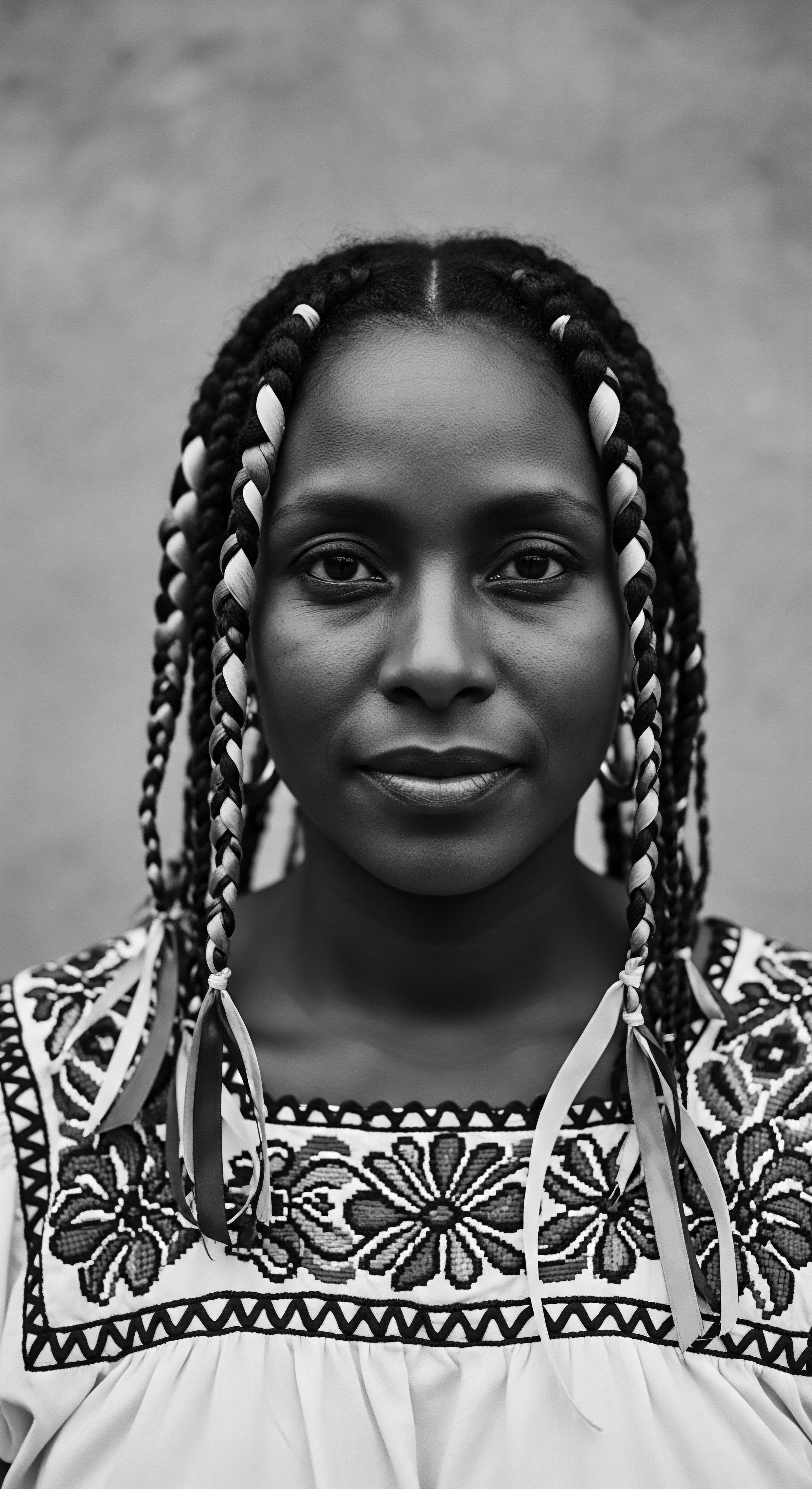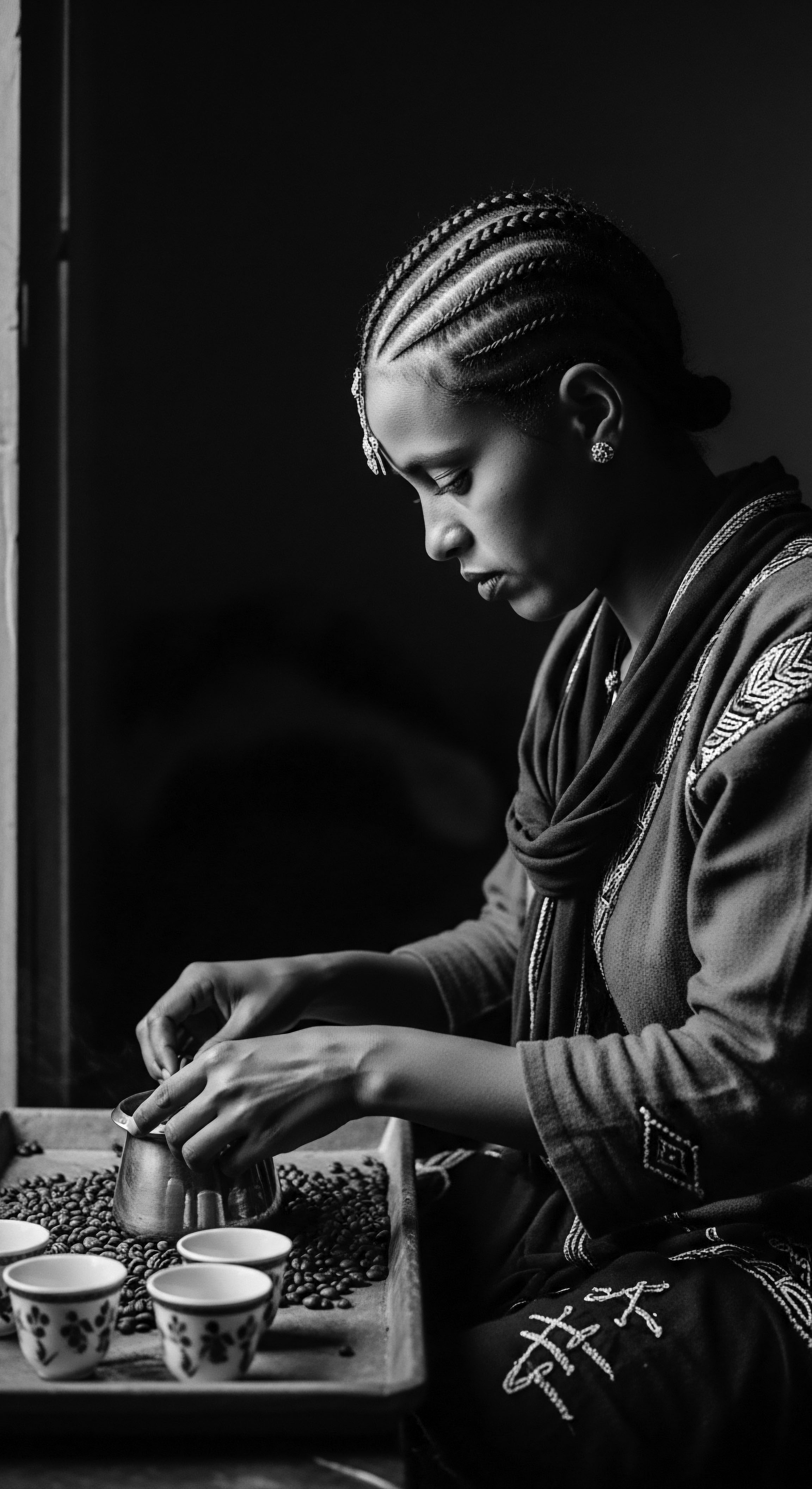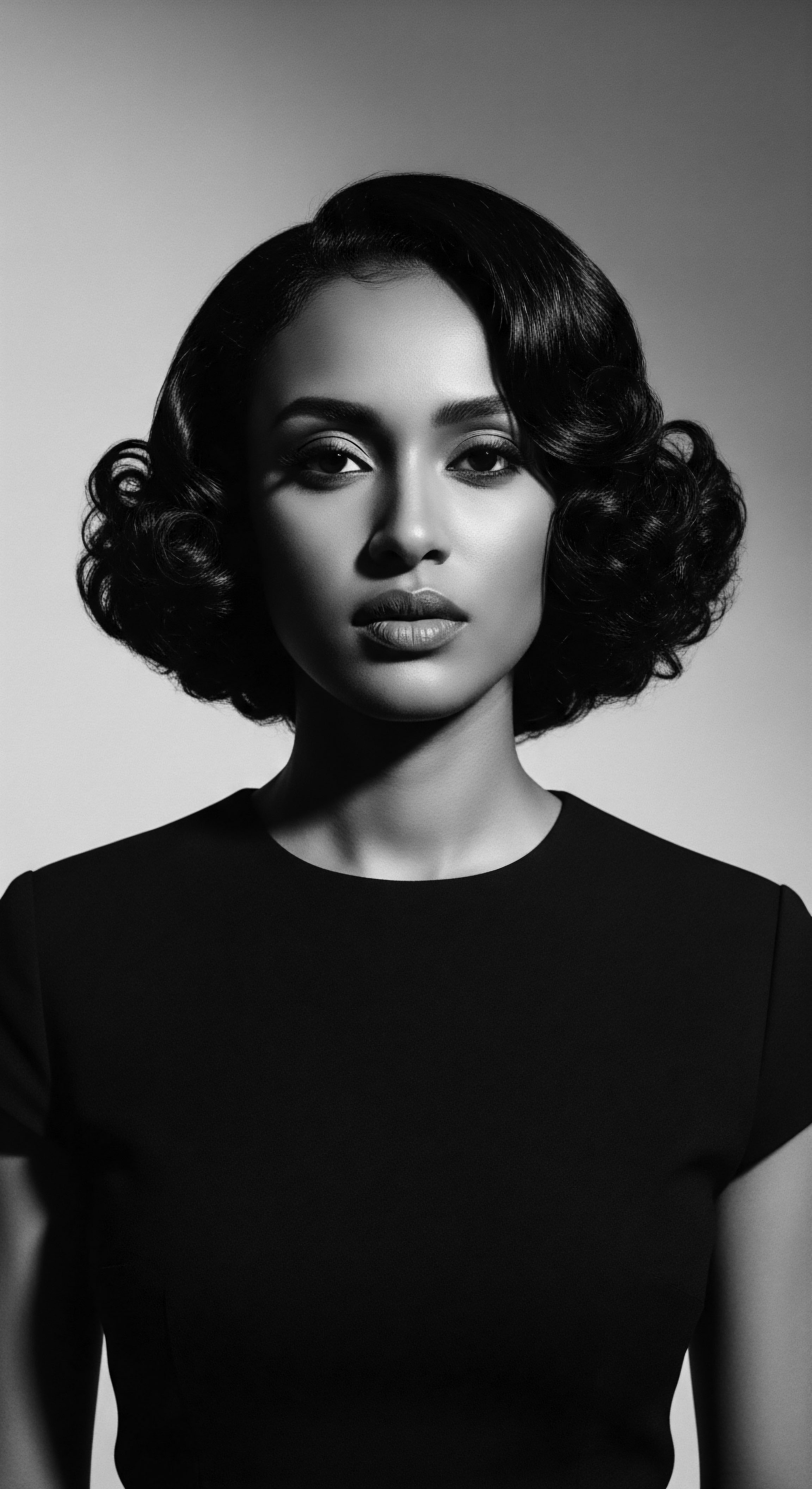
Roots
To truly comprehend how traditional butters aided ancient styling, one must first step back, close their eyes, and feel the strands of heritage. Our textured hair, in its myriad coils, kinks, and waves, carries stories etched into its very genetic memory. It is a living archive, bearing witness to generations of wisdom, resilience, and ingenuity. For countless ancestral communities, particularly those of Black and mixed-race lineage, hair was never merely fiber upon the head.
It served as a conduit for spiritual connection, a social indicator, a medium for artistry, and a shield against the elements. The care given to it was not a fleeting trend, but a deeply ingrained practice, passed down with the reverence of sacred lore.
The very architecture of textured hair, characterized by its elliptical shaft and numerous bends, presents unique considerations. These structural realities naturally lead to greater potential for dryness, as the bends can make it harder for natural scalp oils to travel down the strand. This inherent characteristic, understood through centuries of observation, meant that moisture, protection, and lubrication were paramount for both health and stylistic expression.
Ancient communities, often dwelling in harsh climates where sun and wind were constant companions, instinctively sought remedies from the earth around them. Their hands, guided by inherited wisdom, found solace and solutions in the rich, yielding fats of various plants and even animals.

Elemental Components of Ancient Hair Care
Across continents, indigenous peoples discovered substances that softened, protected, and offered hold to their strands. These traditional butters were not factory-processed concoctions; they were raw, minimally altered gifts from nature, holding the life force of their origin plants or the sustenance of the animal kingdom. Their efficacy lay in their unique molecular structures, brimming with lipids, vitamins, and fatty acids that formed a protective mantle around each hair shaft.
Ancient wisdom recognized the intrinsic needs of textured hair, finding profound solutions in the emollient gifts of the earth.

Understanding the Textural Blueprint and Butters’ Role
The distinct curvature of textured hair means its cuticle layers, which act like protective shingles, are often more exposed at the bends. This exposure can lead to moisture loss and increased susceptibility to damage. Traditional butters, with their dense emollient properties, provided a crucial barrier, sealing in moisture and creating a smooth surface. This function was not merely cosmetic; it directly supported the hair’s structural integrity, allowing for manipulation without undue breakage.
- Shea Butter ❉ Extracted from the nut of the shea tree (Vitellaria paradoxa), abundant in West Africa, it has been a staple for centuries, sometimes called “women’s gold” for its economic significance to communities. Shea butter offers high concentrations of fatty acids and vitamins A and E, making it a powerful moisturizer and protector against environmental stressors.
- Cocoa Butter ❉ From the beans of the cacao tree, native to Central and South America, this butter was revered by ancient civilizations like the Mayans and Aztecs, who used it for both health and ceremonial purposes. It is rich in antioxidants and fatty acids, providing deep hydration and aiding in hair strength.
- Kalahari Melon Seed Oil ❉ Sourced from the seeds of the wild watermelon in Southern Africa’s Kalahari Desert, this golden oil is light yet deeply moisturizing. Its high linoleic acid content helps prevent water loss and supports scalp health without leaving heavy residue.
These natural emollients, sourced directly from their environments, represent a symbiotic relationship between ancestral communities and the land that sustained them. They understood, with a knowing beyond scientific charts, that these butters held the power to nurture, protect, and style the hair that was so deeply tied to identity and social standing. The application of these butters was often a communal act, reinforcing social bonds and transmitting knowledge across generations.

Ritual
The application of traditional butters was seldom a hurried task; it was often a deliberate, purposeful ritual, steeped in cultural meaning and passed down through the gentle, knowing hands of elders. These practices transcended mere aesthetic pursuit, serving as moments for intergenerational bonding, cultural instruction, and the physical reinforcement of identity. The butters themselves provided the foundational slip, hold, and protection necessary for the intricate styling traditions that define textured hair heritage.

How Did Ancestral Hands Style With Butters?
The inherent properties of these traditional butters—their melting points, viscosity, and rich fatty acid profiles—made them indispensable aids in crafting enduring hairstyles. They allowed for the manipulation of coils and kinks into organized, protective forms, while also bestowing a luminous sheen that communicated vitality and careful tending. From the tight geometric patterns of cornrows to the regal stature of braided updos, butters provided both the structural integrity and the lasting hydration required for styles that could remain in place for extended periods, protecting the hair from environmental rigors. In many instances, the butters acted as a pliable pomade, smoothing flyaways and ensuring neatness, or as a sealant to lock in moisture after water-based treatments.

The Himba Way of Ochre and Butter
Consider the Himba people of Namibia, whose distinctive approach to hair styling is a testament to the profound connection between tradition, personal presentation, and the environment. Himba women apply a mixture of ground ochre , sourced from the earth, and animal fat or butter to their hair. This ancestral paste, known as ‘otjize,’ creates a striking reddish-orange hue, symbolizing their connection to the earth, fertility, and life itself. The rich butter within the otjize serves several critical functions ❉ it acts as a sun protectant, shields the hair from harsh desert winds and dust, and keeps the hair deeply moisturized, preventing breakage in their tightly plaited locks.
This practice is not simply about adornment; it is a visible declaration of their identity, their cultural lineage, and their relationship with the natural world. Each stage of a Himba woman’s life is marked by specific hairstyles, with the buttered ochre paste serving as a constant, unifying element, embodying a living, breathing heritage.
From ancient African kingdoms to indigenous American civilizations, traditional butters were the foundational tools for styling, protection, and the communal expression of cultural identity.
Beyond the Himba, other communities across Africa used various fat-based preparations. The Afar tribe , for instance, employed cow fat and butter to shape and maintain their distinctive curls, offering both stylistic hold and protection from the sun. In ancient Egypt, beauty butters, including shea and cocoa butter, or even coconut oil, were valued for their viscosity.
They served as early hair gels, massaged into the hair to create slick styles and a glossy sheen, signaling status. These historical examples illustrate a shared understanding that emollients from nature were central to hair preservation and the creation of aesthetic forms.
The communal aspects of hair styling were also significant. It was not uncommon for several individuals to gather, with one person tending to another’s hair over many hours, sometimes even days, to craft intricate styles. This process was a time for storytelling, for sharing wisdom, and for solidifying community bonds.
The butters used in these sessions provided lubrication for detangling and smoothing, easing the process and making it more comfortable for the one receiving care. This shared activity, centered around the nourishment and presentation of hair, strengthened social ties and ensured the continuity of these cherished ancestral practices.
| Traditional Butter/Fat Shea Butter |
| Primary Origin Region West Africa |
| Styling Function Aided Moisturizing, softening, sealing, light hold for braids and twists. |
| Traditional Butter/Fat Cocoa Butter |
| Primary Origin Region Central/South America, West Africa |
| Styling Function Aided Deep conditioning, adding sheen, structural support for slick styles. |
| Traditional Butter/Fat Animal Fat/Butter |
| Primary Origin Region Himba (Namibia), Afar (Ethiopia), Enslaved Peoples (Americas) |
| Styling Function Aided Protection from sun/elements, detangling, shaping curls, straightening. |
| Traditional Butter/Fat Kalahari Melon Seed Oil |
| Primary Origin Region Southern Africa |
| Styling Function Aided Light moisture, scalp health, detangling without heavy residue. |
| Traditional Butter/Fat These natural fats were fundamental to both hair health and cultural expression across ancient societies. |

Relay
The wisdom embedded in the ancient use of butters for hair styling extended beyond immediate aesthetic appeal. It formed an integral part of holistic care regimens, addressing the fundamental needs of textured hair for long-term health and vitality. These ancestral practices, whether conscious of molecular science or guided by generations of observation, speak to a deep understanding of maintaining hair’s integrity from root to tip. The threads of this knowledge, carefully preserved through oral tradition and lived experience, continue to shape contemporary approaches to textured hair care.

Did Butters Protect Hair Through Nighttime Rituals?
The protection of hair during rest, particularly for textured strands, is a concept deeply rooted in ancestral care. Butters played a substantial part in nighttime rituals, creating a protective layer that shielded hair from friction against rough sleeping surfaces and minimized moisture loss during the hours of repose. Applying a rich butter before braiding or twisting the hair for the night helped to seal the cuticle, keeping the strands supple and less prone to tangling and breakage. This foresight preserved the integrity of intricate daytime styles and prepared the hair for the next day’s manipulations.
This enduring practice highlights a profound ancestral understanding of hair as a vulnerable yet resilient part of the self, deserving of consistent, gentle attention. It represents a continuum of care, a daily commitment to the health and beauty of strands that were, and remain, deeply significant within identity. The nighttime application of butters was a quiet act of self-preservation, a ritual that honored the physical body and its connection to larger cultural narratives of care and well-being.

Ancestral Problem Solving with Natural Fats
Traditional butters offered solutions to common hair concerns long before modern cosmetic chemistry. Their emollient nature made them potent detanglers, allowing combs and fingers to glide through coiled hair with less resistance, thereby reducing mechanical damage. For dryness, a perennial challenge for textured hair, butters provided immediate and sustained hydration.
They softened hardened strands and contributed to a healthy scalp environment, addressing flakiness and discomfort. The protective film they formed also offered a degree of shielding against the elements, including the harsh sun, which could otherwise dry and weaken hair.
One poignant example of ancestral ingenuity and adaptation comes from the experience of enslaved women in the Americas. Stripped of their traditional hair care tools and ingredients, these women, facing immense adversity, repurposed what was available to them. They used animal fats like butter, bacon fat, or goose grease not only for conditioning and attempting to manage their hair but, crucially, to aid in straightening their hair. This was often done in desperate attempts to conform to Eurocentric beauty standards imposed upon them, which could mean the difference between domestic work and brutal field labor.
The fats would be applied to the hair, and sometimes, a heated butter knife or similar implement was used to glide over the buttered strands, providing a primitive form of thermal reconditioning. This practice, born of survival rather than choice, powerfully illustrates the lengths to which individuals were compelled to adapt their heritage practices under oppressive conditions, simultaneously preserving a fragment of hair care tradition while striving for physical safety.
The legacy of traditional butters is a testament to ancestral ingenuity, where natural fats provided solutions for styling, protection, and resilience in the face of environmental challenges and even historical adversity.
The continuity of butter use speaks volumes about their efficacy. Today, the resurgence of interest in natural hair care often sees a return to these foundational ingredients. Modern formulations frequently incorporate shea, cocoa, and other plant-based butters, validating the wisdom of our ancestors through contemporary scientific understanding.
The very properties that made these butters invaluable in ancient styling—their ability to moisturize, protect, and provide structure—remain central to the holistic care of textured hair today. This ongoing dialogue between ancient practice and present knowledge forms a beautiful testament to the enduring power of heritage.
- Moisture Retention ❉ Traditional butters formed a protective occlusive layer, significantly reducing transepidermal water loss from the hair shaft, thus maintaining hydration levels crucial for elasticity.
- Cuticle Sealing ❉ The fatty acids present in butters helped smooth and flatten the hair’s cuticle layers, diminishing frizz and enhancing shine by creating a more reflective surface.
- Mechanical Protection ❉ By coating each strand, butters reduced friction during styling, detangling, and daily wear, offering a buffer against breakage.

Reflection
As we trace the rich lineage of textured hair, the role of traditional butters emerges not simply as a footnote in history but as a vibrant, living chapter in the Soul of a Strand. These natural emollients—shea, cocoa, the fats of the land—were more than mere styling aids; they were instruments of preservation, expressions of cultural identity, and quiet symbols of resistance and adaptation. They carry the echoes of ancestral hands, of communal gatherings under sun-drenched skies, and of resourceful resilience in the face of profound challenge.
The wisdom of using these butters, born from intimate observation and generational knowledge, continues to resonate in our modern understanding of hair health. It reminds us that the quest for radiant, well-tended hair is not a new invention but a heritage practice, deeply woven into the fabric of human experience. Our textured hair, in its glorious diversity, serves as a testament to this enduring legacy, inviting us to connect with the deep past and to honor the pathways paved by those who came before us. This is a story of continuous care, a quiet revolution of inherited beauty that persists through time, always guiding us back to the source.

References
- Cochrane, Ethan E. and Heather M. Sivil. “The Archaeology of Shea Butter (Vitellaria paradoxa) in Burkina Faso, West Africa.” Journal of Ethnobiology 36, no. 1 (2016) ❉ 134-153.
- Dreal, R. D. “What Every Dermatologist Must Know About the History of Black Hair.” Cutis, no. 112 (2023) ❉ 353-356.
- Gyasi, Robert M. and Agyemang, Peter K. “Ethnobotany of traditional plant cosmetics utilized by women; A study in Northern Ghana.” Journal of Ethnobiology and Ethnomedicine 13, no. 1 (2017) ❉ 39.
- Leach, Edward. “Magical Hair.” Journal of the Royal Anthropological Institute of Great Britain and Ireland 88, no. 2 (1958) ❉ 147-164.
- Opoku, Mensah, and Odum, Michael O. “Medicinal and Nutritional Benefits from the Shea Tree- (Vitellaria Paradoxa).” Journal of Biology and Life Science 2, no. 1 (2020) ❉ 11-17.
- Popov, N. Kuleshov, V. and Popova, O. “S ‘Dragging Seventy Little Plaits of Her Across the Land of the Altai’ ❉ Haircare, Hairstyles, and Hair Ornaments of the Southern Altai.” The International Journal of Intangible Heritage 18 (2023) ❉ 145-156.
- Shahin, S. “Historical Perspectives on Hair Care and Common Styling Practices in Black Women.” Cutis, no. 112 (2023) ❉ 353-356.
- Shu’aib, Abdul. African Hairstyles ❉ Cultural Significance and Legacy. Afriklens Publications, 2024.
- Tolba, E. F. and Khaleel, A. H. “Medicinal plants used in cosmetics for skin and hair care.” ResearchGate, 2024.
